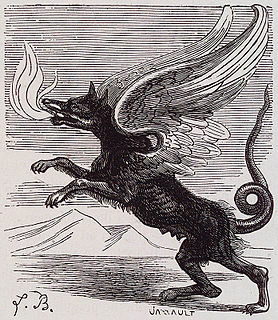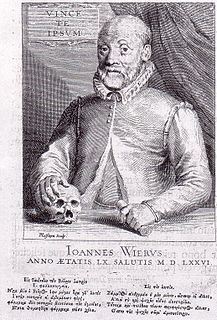Kimaris, also known by the alternate names Cimeies, Cimejes and Cimeries, is most widely known as the 66th demon of the first part of the Lemegeton.

Aamon, in demonology, is a Marquis of Hell who governs forty infernal legions. Aamon is a demon and the Grand Marquis of Hell and the seventh spirit of the Goetia.

Baal is one of the kings of Hell in 17th-century goetic occult writings. The name is drawn from the Canaanite deity Baal mentioned in the Hebrew Bible as the primary god of the Phoenicians.
The Lesser Key of Solomon, also known as Clavicula Salomonis Regis or Lemegeton, is an anonymous grimoire on demonology. It was compiled in the mid-17th century, mostly from materials a couple of centuries older. It is divided into five books—the Ars Goetia, Ars Theurgia-Goetia, Ars Paulina, Ars Almadel, and Ars Notoria.

Goetia or Goëtia is a practice that includes the conjuration of demons, specifically the ones summoned by the Biblical figure, King Solomon. The use of the term in English largely derives from the 17th-century grimoire Lesser Key of Solomon, which features an Ars Goetia as its first section. It contains descriptions of the evocation, or "calling out", of seventy-two demons, famously translated from Latin into English by S. L. MacGregor Mathers and published by Aleister Crowley in 1904 as The Book of the Goetia of Solomon the King.

Agares is a demon described in demonological grimoires.
In demonology, Halphas is the thirty-eighth demon in the Ars Goetia in the Lesser Key of Solomon, ranked as an earl.
In demonology, Amaymon is a Prince of Hell, and, according to some Grimoires, the only one who has power over Asmodai.
Vassago is the third Goetic demon, in the hierarchy of angels of Satan, described in the Lesser Key of Solomon as a prince "of a good nature" and of the "same nature as Agares". He rules twenty-six legions of spirits, and is summoned to tell magicians of past and future events, and locate lost objects. He is one of the few spirits found in the Lesser Key of Solomon but not in Johann Weyer's Pseudomonarchia Daemonum. Vassago is mentioned in the Book of the Office of Spirits as Usagoo, appearing as an angel, "just and true in all his doings," with the powers of inciting the love of women and revealing hidden treasures, in addition to ruling twenty spirits. Sloane MS 3824 mentions Vassago in invocations to summon spirits that guard treasure, and in the "Experiment of Vassago" and the "Experiment of Agares," both intended to capture the named spirits in crystals. According to Rudd, Vassago is opposed by the Shemhamphorasch angel Sitael.
Gamigin is the fourth Goetic demon described in the Lesser Key of Solomon, and forty-sixth in the Pseudomonarchia Daemonum, in both works as a marquis who initially takes the form of a small horse before transforming into a hoarse-voiced human. The Lesser Key of Solomon merely leaves his duties at teaching liberal arts and giving accounts of souls that died in sin.

King Paimon is a spirit named in the Lesser Key of Solomon, Johann Weyer's Pseudomonarchia Daemonum, Collin de Plancy's Dictionnaire Infernal, the Livre des Esperitz, the Liber Officiorum Spirituum, The Book of Abramelin, and certain French editions of The Grimoire of Pope Honorius ; as well as Sloane MS 3824.
In demonology, Morax is a Demon, Great Earl, and President of Hell, having thirty legions of demons under his command. He teaches Astronomy and all other liberal sciences, and gives good and wise familiars that know the virtues of all herbs and precious stones. This profile of the demon can be seen in Pseudomonarchia Daemonum as well as in Goetia.

Gaap is a goetic demon described in the Lesser Key of Solomon, the Pseudomonarchia Daemonum, the Dictionnaire Infernal, and the Munich Manual of Demonic Magic, as a Prince in human form who incites love. The Munich Manual also says that Taob also provides medical care for women, transforms them to make it easier to get to a lover, renders them infertile, and rules twenty-five legions of spirits. The sources besides the Munich Manual also describe Gaap as a President, giving him the powers to teach philosophy and liberal arts, make others invisible, steal familiars from other magicians, make men stupid, and carry men between kingdoms; in addition to ruling sixty-six legions of demons. Johann Weyer also connects Gaap to necromancers, and states that he was first called upon by Noah's son Ham, along with Beleth. He was of the order of potestates.

In demonology, Marchosias is a great and mighty Marquis of Hell, commanding thirty legions of demons. In the Ars Goetia, the first book of The Lesser Key of Solomon, he is depicted as a wolf with gryphon's wings and a serpent's tail, spewing fire from his mouth, but at the request of the magician he may take the form of a man. He is a strong fighter and gives true answers to all questions, and is very faithful to the magician in following his commands. Before his fall he belonged to the angelic order of Dominations, and when he was bound by Solomon he told him that after 1,200 years he hoped to return to Heaven.

Valac is a demon described in the goetic grimoires the Lesser Key of Solomon, Johann Weyer's Pseudomonarchia Daemonum, the Liber Officiorum Spirituum, and in the Munich Manual of Demonic Magic as an angelically winged boy riding a two-headed dragon, attributed with the power of finding treasures.
Amy or Amii is a Goetic demon described in the Lesser Key of Solomon, the Dictionnaire Infernal, in Thomas Rudd's version, the Pseudomonarchia Daemonum, and in the Munich Manual of Demonic Magic as a President, appearing initially as a flame before turning to a human form. He is claimed to teach astronomy and liberal arts, give familiars, incite positive reactions from rulers, and reveal treasures. According to all sources, he rules over thirty six legions of demons. According to Johann Weyer, he was of both the order of angels and potestates (powers), and holds the futile hope of returning to the seventh heaven after twelve centuries. According to Rudd, Amii is opposed by the Shem HaMephorash angel Ieialel.

De praestigiis daemonum, translated as On the Tricks of Demons, is a book by medical doctor Johann Weyer, also known as Wier, first published in Basel in 1563. The book argues that witchcraft does not exist and that those who claim that practice it are suffering from delusions, which should be treated as mental illnesses, rather than punished as witchcraft. It was influential in the abolishment of witchcraft trials in the Netherlands.
The Livre des Esperitz is a 15th or 16th century French grimoire that inspired later works including Johann Weyer's Pseudomonarchia Daemonum and the Lesser Key of Solomon. It contains ideas, traditions, and elements of works dating back to at least the 13th century.











